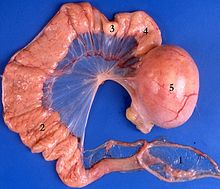Oviduct
As oviduct (lat. Oviductus ; the technical term was also the former name of the fallopian tubes ) at birds designates the portion of the female sex organs, the yolk ball, the finished in the egg produced and the cloaca is transported to the outside. The laying gut is a stretchy, membranous, muscular tube laid in loops (hence the laying "gut"). The egg stays for around 24 hours in domestic chickens, 20 hours of which are spent on shell formation.
The oviduct develops from the Müller duct ( ductus paramesonephricus ). It is originally created in pairs, but the right part already degenerates in the embryo , so that only the left-sided oviduct ( oviductus sinister ) is formed, which is divided into five sections . A distinction is made between the following sections:
- Infundibulum (formation of the hail cords ( Chalazae ), place of fertilization )
- Magnum (formation of protein)
- Isthmus (formation of the shell skin)
- Uterus (egg container, formation of the calcareous shell)
- Vagina (formation of the egg membrane)
The shape of the ovary changes depending on whether the bird can be fertilized or not. During the laying period, the laying intestine increases in size by up to 50 times its volume and, in the case of domestic fowl, reaches a length of up to 860 mm and a diameter of 13 mm.
literature
- Franz-Viktor Salomon (Ed.): Textbook of poultry anatomy . Gustav Fischer, Jena / Stuttgart 1993, ISBN 3-334-60403-9 .

